
In Texas you may come across 17 different species of hummingbird.
These are:
- Mexican Violetear
- Green-breasted Mango
- Rivoli’s Hummingbird
- Blue-throated Mountain Gem
- Lucifer Hummingbird
- Ruby-throated Hummingbird
- Black-chinned Hummingbird
- Anna’s Hummingbird
- Costa’s Hummingbird
- Broad-tailed Hummingbird
- Rufous Hummingbird
- Allen’s Hummingbird
- Calliope Hummingbird
- Broad-billed Hummingbird
- Buff-bellied Hummingbird
- Violet-crowned Hummingbird
- White-eared Hummingbird
Want to learn more? Take a look at the Compete Hummingbird Guide Book – a classic!
The most common hummingbird to be found in Texas is the Ruby-throated Hummingbird.
There are a variety of climates in Texas, depending on where you are in the state. The north west of Texas has a continental climate whilst the rest of Texas is classified as sub-tropical.
There are 80 different state parks in Texas and there are two national parks.
Now that we’ve talked a little about the state of Texas, let’s have a look at the hummingbirds that reside there in closer detail and see what you can do to attract these lovely birds to your garden.
Take a look at our article on the Best Hummingbird Feeder!
What Hummingbirds can be seen in Texas?
Table of Contents
1. Ruby-throated Hummingbird

Fun Facts:
- These hummingbirds feed on nectar, particularly the nectar of both orange and red tubular plants such as honeysuckle.
- These birds are tiny and only weigh 2-6g with their wingspan being 8-11cm.
Only the males of this species have ruby coloured throats. The females have white bellies and necks with brown feathers covering their wings and backs.
These birds are only very small and like to visit meadows and orchards.
Males make their territory before the breeding season so that when a female approaches, they are able to court her with their display flights.
These displays involve looping dives of up to 50ft and if the female is impressed, she will move onto the male’s perch before he makes side to side flights in front of her.
These hummingbirds are most common in Texas during their breeding season and are most commonly seen to the east of the state.
If you want to bring one to your garden, you should make sure to have special hummingbird feeders as well as tubular plants that they can feed from.
2. Black-chinned Hummingbird

Fun Facts:
- They most commonly consume nectar from flowers but will also eat insects when they are more readily available.
- These birds are very small with a weight range of 2.3-4.9g and have an average wingspan of 11cm.
Both sexes of this species have pale white or grey underbellies and the males have dark necks with black and iridescent purple feathers.
They are similar in size to the Ruby-throated Hummingbird and like to stay near rivers.
This species of hummingbird has not been as well studied as others so there is not as much information. It is known that the males performing courting displays that involves dives of up to 100ft.
They have also been observed finding a high perch to survey their territory after they have spent time feeding.
You can see these birds across most of Texas. They are most abundant during their breeding seasons and are most likely to make their nests in the eastern and central areas of the state.
These birds are easy to attract to your garden and simply require an appropriate hummingbird feeder.
Appropriate tubular plants will help as well and remember to change your feeder every few days.
3. Anna’s Hummingbird

Fun Facts:
- These birds will eat nectar from many different flower species and they have also been known to steal insects from spider webs.
- These birds are medium sized for a hummingbird, weighing 3.6g.
These hummingbirds have feathers of mostly green and grey colours and the males of these species have vivid, deep pink feathers on their necks.
The Anna’s Hummingbird does not shy away from urban habitats and can usually be found there.
Males will court a female by performing large swooping dives and dances. They will also sometimes perform a song whilst doing these displays.
These birds are not monogamous and do not stay in breeding pairs.
These hummingbirds are rather rare in Texas compared to others that we’ve talked about.
They are usually seen in the state outside of their breeding season. you are most likely to see one to the far west of the state.
If you have the appropriate hummingbird feeders, it is relatively easy to attract these birds to your garden however this is only the case where they are abundant.
4. Costa’s Hummingbird

Fun Facts:
- These birds will feed on nectar and will also quite often feed on flying insects.
- Weighing only 2-3g they are slightly smaller on the hummingbird weight scale.
These birds are mostly covered in duller and paler feathers but the males have bright purple feathers on their head and face.
In the wild these birds are most commonly found around desert habitats. Males are very defensive of their territory, especially during the breeding season.
They will pick a couple of large perches in their territory from which they will call out to defend it.
Males have a strict courtship display that they stick to which involves a series of aerial dives.
These displays usually last for an average of about 30-40 seconds but they have been observed performing for as long as 4 minutes.
Breeding pairs do not stay together, they will usually mate with multiple individuals and the females will be the one to take care of the young.
These birds tend to live on the west coastlines of the United States but it is possible to see some in Texas during their breeding season.
They are only likely to be seen to the south west of the state.
These hummingbirds are most likely to come to your garden if you have a sugar water feeder, unlike some other species, do not add food colouring to the mix to attract the Costa’s Hummingbird.
5. Broad-tailed Hummingbird
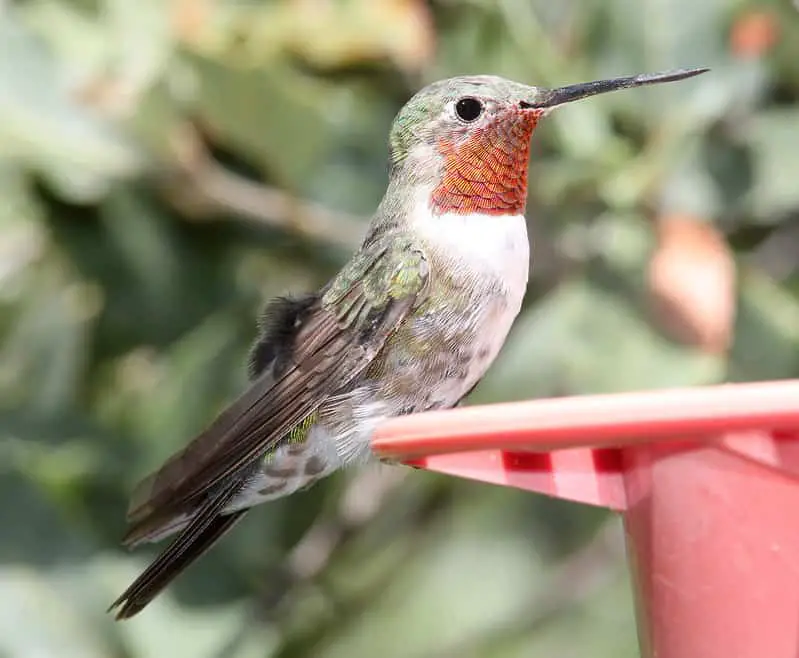
Fun Facts:
- These birds will feed on an even distribution of nectar and insects, mothers will feed insects to their newly hatched young.
- These birds are medium sized for hummingbirds and weigh 2.8-4.5g.
As the name suggests, these birds have broad feathered tails. Their backs are mainly covered in green feathers and males have iridescent pink throats.
During the mating seasons, these birds will mate with several of the species and will not stay together, males will mate with several females.
They will perform dramatic courtship displays for any females that enter their territory.
Broad-tailed hummingbirds have the ability to go into torpor when it is cold and they cannot find enough food, it is a miniature hibernation where they slow their heart rate to conserve energy.
You can see these birds in Texas both during their breeding and migratory seasons.
They can be seen to the west and north areas of the state.
You will be very lucky to attract one of these birds to your garden, but if you want to try make sure you have a sugar water feeder set up and various tubular flowers around your garden.
6. Rufous Hummingbirds

Fun Facts:
- Nectar from tubular plants is the main source of food for this bird.
- These birds are average sized for a hummingbird and weigh 2-5g.
Like lots of other hummingbirds, the females of this species have mostly dull and green feathers. The males on the other hand have feathers of iridescent orange shades.
These birds are migratory and are usually seen in open areas of land.
Rufous Hummingbirds are very aggressive, they can be aggressive over territory and food to both their own species and other hummingbird species.
Food appears to be more important than breeding as males have been seen chasing females away from manmade bird feeders, even in the middle of the breeding season.
You will only see these hummingbirds during the winter months in their migration.
This is when they are most abundant in Texas and can be seen to the west and in the central areas of Texas.
These birds are actually very fond of gardens and may sometimes stay there without any special flowers or feeders.
But they may also deter any other hummingbird species from visiting your garden.
7. Allen’s Hummingbird

Fun Facts:
- A lot of this bird’s diet comes from nectar, but they will also eat small amounts of insects.
- They are similar in size to a lot of other hummingbirds, weighing 2-4g.
Allen’s Hummingbirds are covered in coppery colours when they reach adulthood. These colours are paler shades on the females and brighter on the males.
They are usually found in coastal areas with males being in more open spaces. During the breeding season, males will pick a permanent perch to perform their courtship displays for the females.
As with most other hummingbirds, males will mate with multiple females and the pairs do not stay together, females will take care of the young on their own.
It is rare to see these birds in the state of Texas, but they will occasionally come to the state in their winter months and migratory periods.
Even then they are scarce, and you are only likely to see them in the western areas of the state.
You will have the best chance of attracting these birds by placing sugar water feeders in your garden, keep them filled in the winter and change them every few days for freshness.
8. Calliope Hummingbird
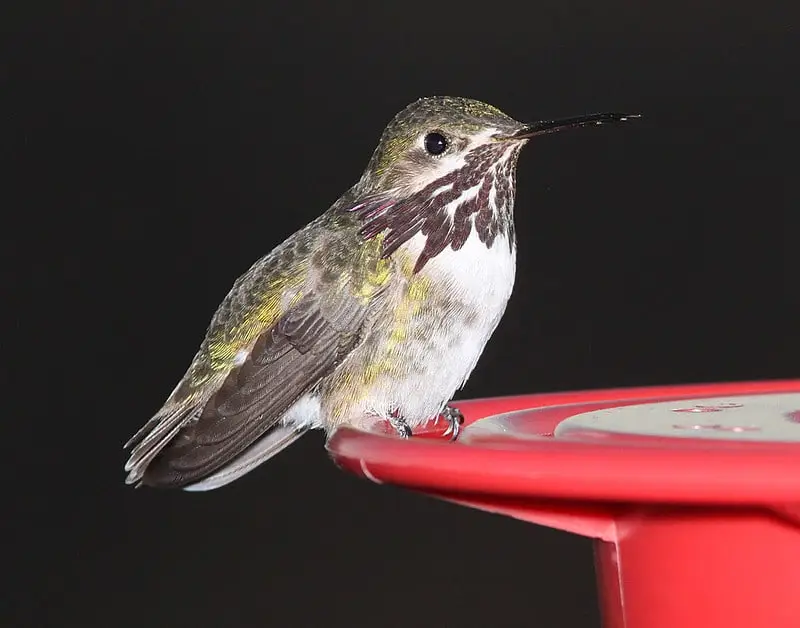
Fun Facts:
- These birds will consume nectar as their main food, usually from cupped flowers.
- Calliope Hummingbirds are on the smaller side only weighing 2.4-3.3g.
These birds have bright white bellies and the males of the species have scattered purple feathers on their plumage.
They are commonly found in open areas such as meadows, but they will breed at higher elevations where possible.
Males are very defensive over their territory and will spend a large amount of their time on high perches observing their territory.
To court a female, males will put on a shuttle display which involves hovering by the females and making their flapping wings sound like bees buzzing.
These birds are not permeant residents in Texas but will often make a temporary home during their migratory seasons.
During their migrations, you are most likely to see these birds in the western areas of the state and even then, they are not very abundant.
These birds are harder to entice into your garden, but you may still get one visiting if you put up a sugar water feeder. Also adding tubular and colourful flowers will increase your chances.
9. Broad-billed Hummingbird
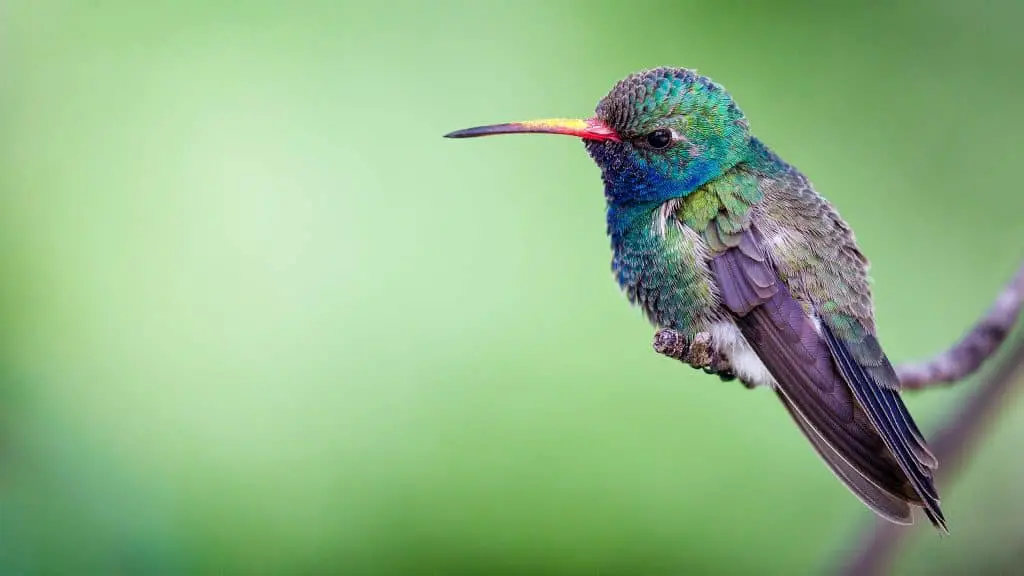
Fun Facts:
- Nectar is the primary food source for these birds but they will also eat insects that they find on plants.
- These birds are average for a hummingbird and have a weight range of 3-4g.
These birds are covered in bright blue and green feathers with a bright red bill. They usually spend their time foraging in canyons and meadows.
Males will call for females from their perches to attract them into their territory. Once a female enters the male’s territory the male will then perform a courtship display for them.
Males will sometimes perform the same display to other males of the species, this is thought to be a warning display.
Breeding pairs do not stay together, and females raise their young by themselves.
The ranges of this bird are less studied than other hummingbirds, so it is not known if there are any permanent residents in the state of Texas.
That being said, they have been seen during their breeding seasons in the very south of the state.
Due to their preference of open country, they are not frequent garden visitors.
But they can be attracted by a sugar water feeder, without any food colouring, they also tend to visit brightly coloured flowers.
10. Buff-bellied Hummingbird

Fun Facts:
- The only thing known about their diet is that they consume nectar.
- These birds are average sized for hummingbirds and weigh between 2 and 4g. We do not know their average wing span.
These hummingbirds are average sized and are covered in dullish green feathers and they have a long, bright red beak.
This species has been studied a lot less than other species but they are known to prefer to stay in areas of open woodlands.
Both males and females in this species are very defensive and aggressive, particularly over food sources.
Not much is known about their specific courtship displays, but it is known that breeding pairs do not stay together and that the females raise the young completely on their own.
Whilst there is not as many comprehensive studies on this hummingbird and its range, it is known that there are some that permanently reside in Texas.
These permanent residents can be found along the south east coastlines of the state.
As these birds have not been studied as thoroughly, there are not many specifics on how to attract them to your garden.
You will be incredibly lucky if you get one of these little guys as a visitor and your best hope of seeing one is to place a sugar water feeder in your garden.
11. Violet-Crowned Hummingbird
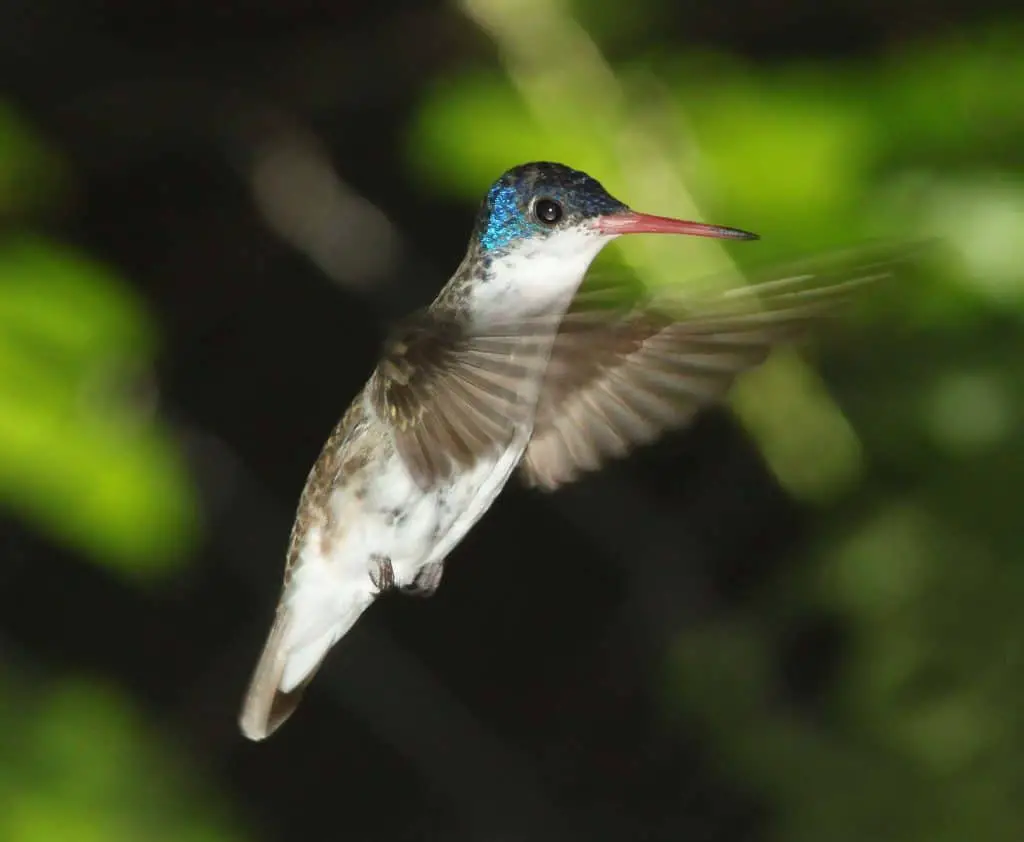
Fun Facts:
- The feed on nectar when flowers are abundant and will consume insects as well.
- They are average sized for a hummingbird, weighing an average of 5g.
This bird has a bright white belly and a blue and purple feathered head. Their bills are also a pinkish red.
Not a lot is known about this hummingbird, but it is known that they much prefer to stay in woodlands, mainly along riverbanks.
Their range in the U.S has not been largely studied but they are known to be common in Mexico.
Their breeding acts have not been well studied but it is known that they emit a squeaky call during their breeding season.
As mentioned earlier, their range in the United States is not well known, but we do know that they are visitors to Texas.
They have been seen in both the south west and south east areas of the state, though they are not very common.
These birds are used to bird feeders and will use them easily so all you will need is an appropriate sugar water feeder.
That being said you will be very lucky to get one due to their abundance.
12. White-eared Hummingbird
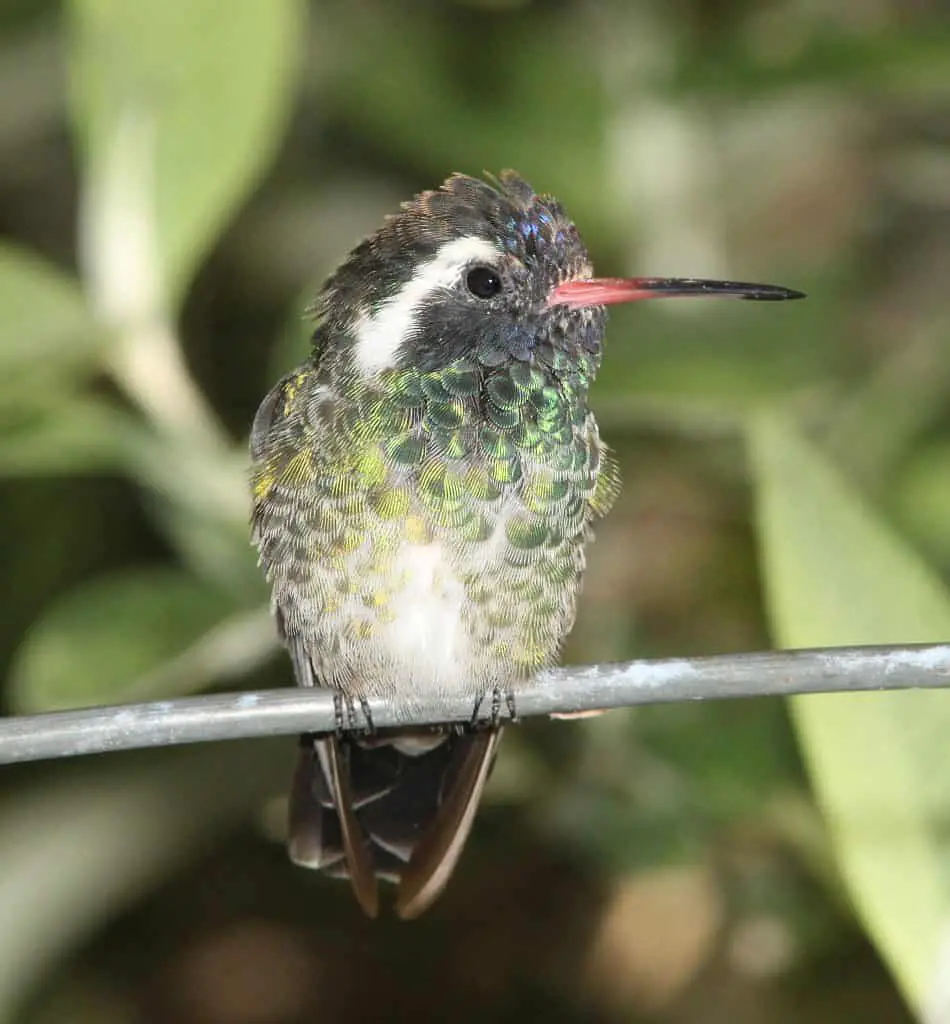
Fun Facts:
- They mostly eat nectar from flowers but will also eat tiny insects.
- They are average sized for a hummingbird and weigh about 4g.
These hummingbirds are known for their distinctive white stripes that go across their face where their ears are hence the name.
Their backs and wings are covered in green feathers and they have a black feathered head.
These birds like to spend their time in the mountainous forests, perched on high branches singing songs to attract females.
As with most other hummingbirds, the females raise the young on their own and this species is believed to be polygamous as they do not form breeding pairs.
This species is most common in Mexico but it has also been seen in the states and in Texas.
They are most common outside of the breeding season and have mainly been seen in the south west of the state.
They are used to bird feeders in the wild so placing sugar water feeders in your garden will give you a good chance of attracting one to your garden. Make sure that it is maintained.
13. Mexican Violetear

Fun Facts:
- These birds are medium sized for a hummingbird and weigh an average of 5.9g.
- Their main diet consists of a combination of nectar and small insects.
The Mexican Violetear is a hummingbird covered in iridescent green and blue feathers.
They can be often seen in open areas, close to flower banks on roadsides, but they prefer to make their nests in pine forests.
These birds are known for their song which is described as a metallic chirping and they are known to perform this song atop of high perches.
As the name suggests, these birds are most commonly found in Mexico but they are seen often in Texas.
They are usually found to the south of the state and it is mainly outside of their breeding season.
The best thing you can do to try and attract one of these birds to your garden is by placing a variety of colourful tubular and cupped flowers for them to feed from.
14. Green-breasted Mango

Fun Facts:
- These birds are on the larger side for a hummingbird, weighing an average of 7g.
- They primarily feed on nectar but will also eat insects.
The adult males of this species are covered in bright green feathers, whilst the females have white and black bellies.
You are most likely to see this hummingbird in open areas of land, feeding and calling from high up perches where they observe their territory.
Their call has been described as a tsup sound.
These birds are almost exclusive to Mexico, with a small number making their homes in the south of Texas for the year.
The Green-breasted Mango is used to bird feeders and will often visit gardens to use them.
As long as you have a stocked hummingbird feeder you may be able to attract these birds without any issue.
15. Rivoli’s Hummingbird

Fun Facts:
- The main diet of a hummingbird consists of nectar as well as lots of insects, particularly during the summer months.
- These birds are on the larger side for hummingbirds and weigh 7-8g.
The males of this hummingbird species have iridescent blue feathers covering their neck and green feathers on their back.
In the light the under feathers on their wings appear a pinkish shade. the females have duller green and brown feathers.
There are no known courtship displays made by this hummingbird, but it is known that are not monogamous and do not form breeding pairs.
They also seem to nest when insects are most abundant. Females raise their young on their own and will also spend time defending them and the territory.
These birds tend to only be in Texas during their breeding season. In this time, you are most likely to see them in the south west of the state.
You will be very lucky to attract one of these hummingbirds to your garden, but your best bet is to place sugar water feeders around your garden. Do not add food colourings to these sugar feeders.
16. Blue-Throated Mountain Gem

Fun Facts:
- They primarily feed off of nectar and insects but will also eat some spiders.
- These birds are large for a hummingbird and weigh from 8.1-8.6g.
This bird has mostly slate grey feathers covering its body, but they get their name because of the striking deep feathers that the male has on their throat.
These birds like to stay in woodland areas either close to or on the mountains.
Whilst males do not perform a flying courtship display, they still have a strict courting ritual that involves singing and fluttering their tail feathers.
These birds are often year-round residents of Texas but are most likely to be seen during their breeding seasons. They are most about to the south and the west of the state.
Whilst these birds prefer to stay in woodlands rather than urban areas, you may be lucky and see one visiting your garden if you have a sugar water feeder in place.
17. Lucifer Hummingbird
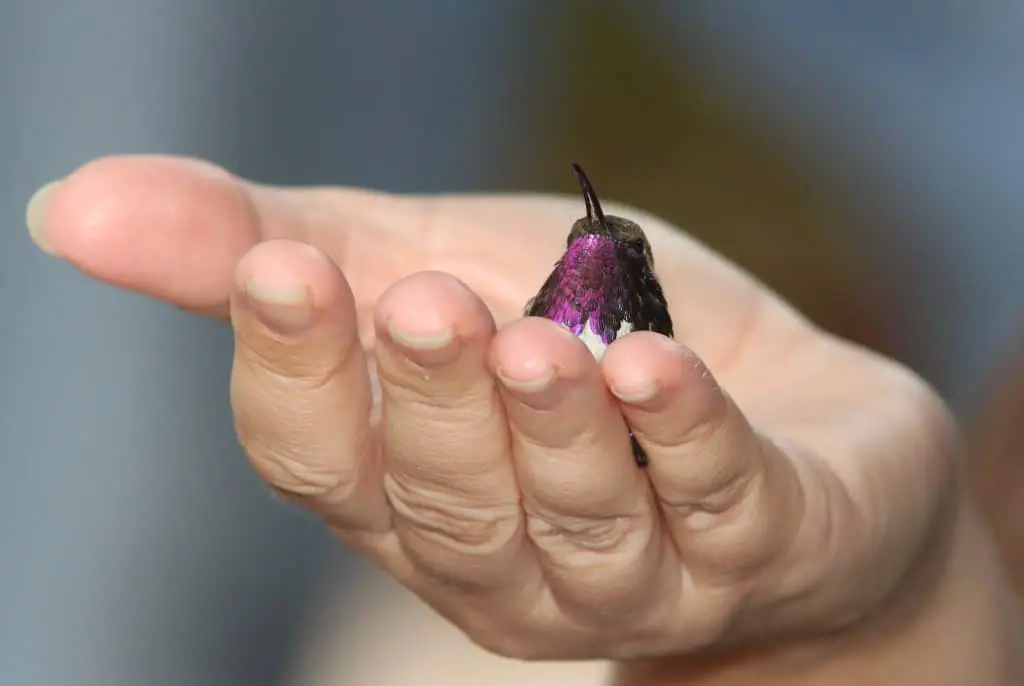
Fun Facts:
- These birds mostly eat nectar, particularly from agave.
- They are medium sized for a hummingbird, weighing around 3-4g.
Male Lucifer Hummingbirds have greyish green feathers covering their body and a purple feathered throat. The females have dulled, green feathers with a rusty belly.
Males are protective of their territory and will chase off other hummingbirds that go near their food sources. They will even chase females away.
These birds are not monogamous and do not form breeding pairs, but unlike other hummingbirds, the males go to the female’s territory to perform their courting display.
The most popular time to see one of these hummingbirds in Texas is during their breeding season.
They are most commonly seen in the west of the state at this time.
These birds prefer to stay in wooded, open areas rather than urban areas so it is rare to see one in your garden.
But if you have sugar water feeders then you may be lucky and get a visit.

More Articles.

Best Binoculars for Bird Watching 2020
Article Summary: Best Budget Binoculars: Nikon 8250 Aculon 16×50 Best Mid-tier Binoculars: Nikon Monarch 5

Cardinals are one of the most beautiful birds around and are known to delight birdwatchers

How to Attract Bees to Your Yard?
Bees play a vital role in the environment, helping to spread the pollen of flowers

About Us
We are avid bird-watchers who recently retired, allowing us more time to travel the world. Fortunately, we have managed to visit numerous countries around Europe, Asia, and America. Watching and photographing birds has been a passion for many years and we are making the most of the extra time on our hands!

I learned quite a bit by reading the Texas hummingbirds. We were just watching the black chinned male this evening. First I’ve ever seen.
Thank you!